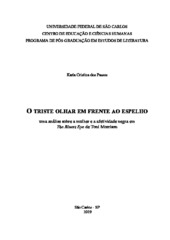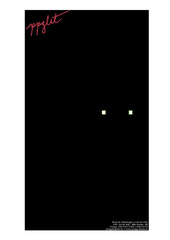| dc.contributor.author | Passos, Karla Cristina dos | |
| dc.date.accessioned | 2021-01-27T11:58:31Z | |
| dc.date.available | 2021-01-27T11:58:31Z | |
| dc.date.issued | 2019-02-28 | |
| dc.identifier.citation | PASSOS, Karla Cristina dos. O triste olhar em frente ao espelho: uma análise sobre a mulher e a afetividade negra em The Bluest Eye de Toni Morrison. 2019. Dissertação (Mestrado em Estudos de Literatura) – Universidade Federal de São Carlos, São Carlos, 2019. Disponível em: https://repositorio.ufscar.br/handle/ufscar/13776. | * |
| dc.identifier.uri | https://repositorio.ufscar.br/handle/ufscar/13776 | |
| dc.description.abstract | The present study sets out to examine the book The Bluest Eye (1970), a novel authored by Toni Morrison focusing on the theme regarding affectivity and black women recited in the narrative. For such, we employ a theoretical-critical perspective that allows us to bring together the work to the period’s social and historical context of publication as well as the 1940s, a period in which the narrative undergoes. We analyzed through a dialectical manner the work’s form and content, intending to heighten the discussions associated to women and black affection expressed in the novel. To that end, we cast the reflections of theorists who debate the relationship concerning literature and society like Antônio Candido, Roberto Schwarz and Fredric Jameson. We will employ, as a thematic field, the memories of characters such as Claudia McTeer, Pauline Breedlove and Cholly Breedlove, as well as some of the work’s autobiographical features. The character Claudia will be emphasized for being the very narrator of the novel and her questions sanction us to access the perspectives of life handed out to black girls and women in the narrative. Claudia is also recited as the author's voice throughout the text, vindicated by the novel’s scenery and a statement by the author concerning her inspirations. The Breedlove’s analysis is established through an inner focus on their childhood and adolescence flashbacks regarding origins and traumas. It is through the narrator and the focal intensification we seek to entree the author's utopian impulse to render the subordinate position of these women in the United States of the 1940s, their social and family status, the violence and financial lacking, also from rights and affection in which they were downcast. | eng |
| dc.description.sponsorship | Não recebi financiamento | por |
| dc.language.iso | por | por |
| dc.publisher | Universidade Federal de São Carlos | por |
| dc.rights | Attribution-NonCommercial-NoDerivs 3.0 Brazil | * |
| dc.rights.uri | http://creativecommons.org/licenses/by-nc-nd/3.0/br/ | * |
| dc.subject | Literatura e sociedade | por |
| dc.subject | Afetividade negra | por |
| dc.subject | Toni Morrison | eng |
| dc.subject | Black women | eng |
| dc.subject | Black affectivity | eng |
| dc.title | O triste olhar em frente ao espelho: uma análise sobre a mulher e a afetividade negra em The Bluest Eye de Toni Morrison | por |
| dc.title.alternative | The sad look in front of the mirror: an analysis concerning black women and the affectivity in The Bluest Eye by Toni Morrison | eng |
| dc.type | Dissertação | por |
| dc.contributor.advisor1 | Rodrigues, Raquel Terezinha | |
| dc.contributor.advisor1Lattes | http://lattes.cnpq.br/2468134516070432 | por |
| dc.description.resumo | O presente estudo tem como objetivo analisar o livro The Bluest Eye (1970), romance da autora Toni Morrison sob o recorte temático das afetividades e das mulheres negras narradas no romance. Para tanto, empregamos um perspectiva teórico-crítica que nos permite relacionar a obra ao contexto social e histórico do período de sua publicação e dos anos de 1940, período em que se passa a narrativa. Analisamos dialeticamente a forma e o conteúdo da obra, visando aprofundar as discussões relativas à mulher e à afetividade negra expressas no romance. Com essa finalidade, lançamos mão das reflexões de teóricos que discutem a relação entre literatura e sociedade como Antônio Candido, Roberto Schwarz e Fredric Jameson. Usaremos como recorte temático as memórias das personagens Claudia McTeer, Pauline Breedlove e Cholly Breedlove, bem como alguns elementos autobiográficos da obra. A personagem Claudia será destacada por se tratar da narradora do romance e seus questionamentos nos permitem acessar as perspectivas de vida apresentadas às meninas e mulheres negras do romance. Claudia também é lida como voz da autora no texto, leitura justificada pela ambientação e por uma declaração da autora quanto às suas inspirações. Já a análise sobre o casal Breedlove se baseia nas focalizações internas e flashbacks sobre suas origens e traumas de infância e adolescência. É por meio da narradora e das focalizações que buscamos acessar o impulso utópico da autora em retratar a condição subalternizada destas mulheres nos Estados Unidos da década de 1940, seu status social e familiar, a violência e a privação financeira, de direitos e de afeto a que eram subjugadas. | por |
| dc.publisher.initials | UFSCar | por |
| dc.publisher.program | Programa de Pós-Graduação em Estudos de Literatura - PPGLit | por |
| dc.subject.cnpq | LINGUISTICA, LETRAS E ARTES::LETRAS::LITERATURAS ESTRANGEIRAS MODERNAS | por |
| dc.publisher.address | Câmpus São Carlos | por |
| dc.contributor.authorlattes | http://lattes.cnpq.br/3691346915058567 | por |


